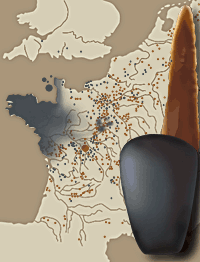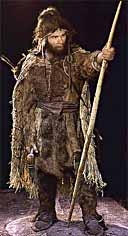- Home
- Discover the megaliths of Morbihan
- The Neolithic period
- Introduction
Modern man, otherwise known as Homo sapiens sapiens, has been the only species of hominid living on Earth for the past twelve thousand years. Various "races" of the species then gradually emerged, producing the diversity that we know today and which characterises the human species.
The Neolithic age (meaning new stone age, as opposed to previous eras: the Paleolithic age and the Mesolithic age) was an age of:
Technical innovation
- Stone polishing methods (that is why the era used to be called the Polished Stone Age),
- Clay working (ceramics),
- Animal and plant fibre processing (weaving and wickerwork),
- Woodwork (carpentry, dugout canoes, joinery and domestic tooling),
- Arable farming (land clearance and preparation for cultivation),
- Animal husbandry (with the domestication of cattle, pigs, sheep and goats).
Sedentary (or partly nomadic) settlements as the dominant form of habitat
- The emergence of permanent settlements with real dwellings, explained by the need to watch over crops.
The physical types of the various neolithic peoples, as recreated from the study of skeletons, differ from one area to another. However, anyone meeting these men and women today would find it very difficult to believe they came from the Neolithic Age (except for their clothes of course!).
During the Neolithic age, people in temperate Europe lived in an environment physically and biologically dominated by the forest. However, their relationship to the forest was very different from the relationship their predecessors had with it.
Their social organisation meant that different groups developed their own cultures: these were therefore both autonomous and related to the cultures of other groups located in the vicinity or in the area. These links were established by the exchange of goods, sometimes over large distances (polished axes, flint blades, gem sets, etc.).
They were also in contact with other groups that continued to live as hunter-gatherers (the Mesolithic people). Some of the latter gradually became assimilated while others were simply wiped out.
These Neolithic basket bases found preserved in the mud at Auvernier (Switzerland) bear witness to the skill of the Neolithic basket makers.
The resulting social structure implies the emergence of "elites". At the same time, religious thought began to emerge in an organised way (even though people at that time certainly did not feel the distinction between the secular, the sacred, the economic, the political and the emotional as we do today).
Two examples of objects widely circulated in the Neolithic.
Polished ax in dolerite in its antler sheath (dredging of the Leguer, Côtes-d'Armor)
Potteries, axes and adornment of the Neolithic morbihannais
These funds of Neolithic baskets kept in the mud at Auvernier (Switzerland) testify to the skill of Neolithic weavers.
Otzi's re-enactment, ''the man from the ice'', made by E. Daynes of the Daynes workshop © Ph. Plailly/Eurelios





